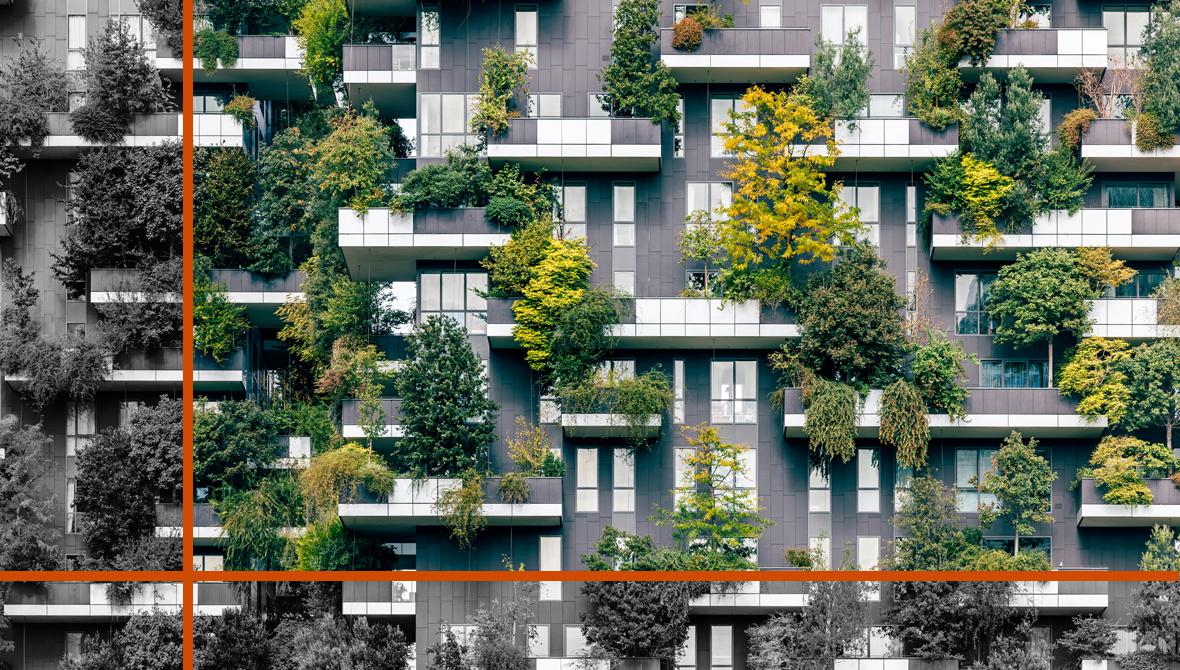How to build a sustainable city at scale
A new net-zero model neighborhood is taking off in Berlin.

A series of giant white X’s painted on the tarmac in Berlin’s city center signals to pilots that the landing strip of the historic Tegel aerodrome, a product of the 1948 Soviet blockade of the city, is permanently shut. But look closer and there are plenty of signs of a new enterprise taking off: Berlin TXL, in planning for more than a decade, is now emerging as one of the biggest and perhaps most ambitious urban development projects in Europe. Named for the old airport’s three-letter identifying code, TXL is already home to startups, and, when complete, it will have a university campus and housing for 10,000 people who won’t have to walk more than five minutes to get to shops, schools, and medical facilities.
In effect, Berlin TXL is an €8 billion–plus (US$8.6 billion) sandbox for figuring out sustainable urban development at scale. Its goal is to show that construction can be carbon-neutral, technology can add to quality of life without crossing privacy borders, and climate-proof housing can be affordable. As PwC’s 2023 report Building sustainable cities: How urban infrastructure can address energy challenges and shocks makes clear, the way that existing and entirely new cities shape their energy infrastructure—and especially the degree to which they can use alternative fuels to power their operations—will have a defining impact on our ability to move beyond fossil fuels over the coming decades. Cities will be the stage on which the transition to net-zero emissions is played out.
“We’re testing how cities of the future can be built, developing a model quarter that’s sustainable and inclusive,” Gudrun Sack told me. Sack is managing director of Tegel Projekt GmbH, a state-owned business commissioned by the city of Berlin to develop and manage Berlin TXL. She sees the project as a possible path for other developments: “We can’t continue building the way we have, and that’s what TXL is—an example to show that it can be done differently.”
According to the United Nations, cities consume about 78% of the world’s energy and account for more than 60% of global greenhouse gas emissions. Urban transport alone accounts for the equivalent of 4 billion metric tons of CO2 emissions, which is more than 40% of the transport sector’s total emissions, according to the International Energy Agency.
Several big cities have made considerable strides in moving toward net zero. Paris plans to restrict access to its center for some cars in 2024. Mexico City, this year, will complete one of the world’s largest urban solar farms on the roof of the municipal wholesale market. Burlington, in the US state of Vermont, obtains all its electricity from renewable sources, albeit to a large extent by burning wood. Woven City, located in Japan and sponsored by Toyota, is to be a type of living laboratory for new mobility technologies. And Fishermans Bend is an urban renewal project set to be completed by 2050 in Melbourne, Australia, that shares some of the objectives of Berlin TXL.
But TXL is unique in many ways, not least because of its scope and location. It also stands apart because of how it’s using an ecosystem approach to development. So how will it address the challenges of remaining sustainable?
Innovation rules
Berlin wants to be climate-neutral by 2045. For Berlin TXL, that means adhering to the so-called triple-zero strategy: erect buildings that consume zero energy, emit zero carbon, and leave behind zero waste. The aim is that the use of energy-intensive concrete, steel, and plastic will be kept to a minimum.
Instead, the project’s residential quarter will be built primarily with lumber from forests surrounding the city. Costs may initially exceed those of conventional materials, in part because the manufacturing process is still labor-intensive. But scaling timber construction to an industrial level through digitized processes and open standards could reduce costs by around 20 to 25% in the medium term, according to a study by the Technical University of Berlin and the Fraunhofer Institute for Wood Research. And wood constructions are highly effective carbon sinks, meaning that for many years they bind potential greenhouse gases that would otherwise be emitted, were the trees to decompose naturally or burn.
“City quarters could thus become huge CO2 stores and have a positive effect on the climate,” I was told by Philipp Bouteiller, who, as chief of Tegel Projekt GmbH for a decade through 2022, was one of the intellectual architects behind TXL. And there’s room to run: while 92% of new homes in the US are wood-framed, in Germany, wood houses make up less than 20% of all new homes.
We know that heat pumps work, we know that fuel cells work—what we need to demonstrate is the entire system, that everything works together in an entire district.”
The Schumacher Quarter, the residential sector within the TXL project, is earmarked to have 5,000 climate-neutral apartments. “We know that heat pumps work, we know that fuel cells work—what we need to demonstrate is the entire system, that everything works together in an entire district,” said Jürgen Peterseim, Berlin-based director in sustainability services at PwC Germany and coauthor of Building sustainable cities, when I asked him about the project. “There are still people who say in a complete system it doesn’t work, so it needs to be shown once and for all that it does work.”
(Making it work would be a historic endeavor in more ways than one: to prepare the Schumacher site, salvage crews are busy recovering tons of unexploded ordnance from two world wars and a shooting range used by the kaiser’s army until the end of the 19th century.)
Industrial action
Elsewhere, the TXL sandbox is alive with industrial activity. Past the rust-orange and lime-green main hangar, engineers test autonomous vehicles as they maneuver through obstacle courses. Other startups, too, have set up shop in the Urban Tech Republic, an industrial and research park within TXL aimed at developing clean urban technologies. These organizations include HH2E, a hydrogen and renewable energy developer, and Futr Hut, a think tank for developing innovative materials and timber construction practices.
EasyMile, a Toulouse, France–based driverless technology company, which originally set up shop at TXL to do maintenance on vehicles for the old site’s airline clients, is expanding operations in the new environment. “TXL is really convenient, because we have office space, a workshop, and testing grounds all in the same place—you don’t often find that,” Nathalie Teer, head of strategic affairs at EasyMile, told me. “We’re considering expanding our R&D operations to Germany, and if we do that, the startup vibe would be really interesting. That sort of ecosystem makes a difference.” (Vay, an autonomous mobility company housed at TXL, drove the first remotely steered vehicle on a public road in Europe in February.)
The whole Urban Tech precinct will have what is called a low-energy network, a heating system comprised of water pipes that travels through the entire precinct and flows at temperatures of 40 degrees Celsius in the winter and 20 degrees in the summer. Compared to standard district heating, with flow temperatures of up to 100 degrees, the low-energy network has far lower losses. The whole system will be implemented in a public–private partnership between the Germany-based multinational E.ON and the city-owned utility Berliner Stadtwerke in time for completion of the first apartments in 2028.
Building trust, too
For any smart city to have the support and confidence of its residents, it needs to be transparent, particularly with its technologies and data. In order to allay concerns over data privacy and AI-driven monitoring, the system running TXL will be open-source coded and feature a showroom so that residents can better understand and learn ways to benefit from technology and data. Part of that system is already on display at an info center that was opened in April 2023.
Digitizing so many aspects of life will create not just a smart city but, in some ways, a smart society. For example, sensors that continuously measure the flow of bicycles and pedestrians can provide wheelchair users options for the least-crowded path; the same sensors can monitor open parking spaces or public transport departure times at mobility centers to maximize efficiency.
AI will also process data to help manage rainwater storage according to the “sponge city” principle, which aims to protect against more extreme weather, be it heavy rain, drought, or heat. Instead of rainwater being channeled into canals, it will be directed to planted rooftops, flood plains, and underground storage that all help cool the city on hot summer days, thus promoting climate change adaptation. Berlin TXL expects to use rainwater to help create its own microclimate. The goal is for the whole area to generate at least as much energy and water as is consumed. Add to that a system of motion-triggered cameras to monitor local fauna, as well as heat sensors and aerial photography to study the microclimates and plant life, and you have a real-time laboratory that will allow climate technologies to continuously adapt to the changing environment, an approach also called climate resilience.
ESG with a capital S
All this activity has drawn massive international interest. Sack, the project’s managing director, said she gets roughly 50 to 100 visitors each week, mostly city planners and politicians (including US Secretary of Housing and Urban Development Marcia Fudge in September 2022). Many come to see the project not only for its sustainable technology but also its broader environmental, social, and governance (ESG) policies, including targets for social equality and diversity.
Since the fall of the Berlin Wall in 1989, the city has witnessed its share of large-scale development projects, as it essentially rebuilt much of its center and the former East Berlin. But not all of the projects were successful. Plans for another former airport, Tempelhof, were botched, first because of a lack of citizen participation and then because of a very decisive public vote against any development.
The new Berlin Brandenburg Airport, southeast of the nation’s capital, was delayed for nine years due largely to poor planning and a lack of oversight. That won’t be the case at Berlin TXL, said Sack. “Berlin has learned a lot from the past. The fact that Berlin TXL is better positioned may have to do with the mistakes that were made in the past,” she told me. “After this long planning phase, it is important to me that we can get started now. We have to start boldly, and then we’ll see how it goes.”
Author profile:
- Raymond Colitt is a journalist with three decades of experience reporting, writing, and editing stories from around the globe, including Brazil, Germany, and the US. He has worked for the Financial Times, Reuters, and Bloomberg and currently divides his time between Berlin, Los Angeles, and Brasilia.


